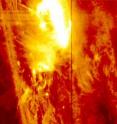NASA's IRIS spots its largest solar flare
On Jan. 28, 2014, NASA's Interface Region Imaging Spectrograph, or IRIS, witnessed its strongest solar flare since it launched in the summer of 2013. Solar flares are bursts of x-rays and light that stream out into space, but scientists don't yet know the fine details of what sets them off. IRIS peers into a layer of the sun's lower atmosphere just above the surface, called the chromosphere, with unprecedented resolution. However, IRIS can't look at the entire sun at the same time, so the team must always make decisions about what region might provide useful observations. On Jan. 28, scientists spotted a magnetically active region on the sun and focused IRIS on it to see how the solar material behaved under intense magnetic forces. At 2:40 p.m. EST, a moderate flare, labeled an M-class flare -- which is the second strongest class flare after X-class -- erupted from the area, sending light and x-rays into space.
IRIS studies the layer of the sun's atmosphere called the chromosphere that is key to regulating the flow of energy and material as they travel from the sun's surface out into space. Along the way, the energy heats up the upper atmosphere, the corona, and sometimes powers solar events such as this flare.
IRIS is equipped with an instrument called a spectrograph that can separate out the light it sees into its individual wavelengths, which in turn correlates to material at different temperatures, velocities and densities. The spectrograph on IRIS was pointed right into the heart of this flare when it reached its peak, and so the data obtained can help determine how different temperatures of material flow, giving scientists more insight into how flares work.
The IRIS mission is managed by the Lockheed Martin Solar and Astrophysics Laboratory of the ATC in Palo Alto, Calif. NASA's Ames Research Center in Moffett Field, Calif., is responsible for mission operations and the ground data system. The Ames Pleiades supercomputer is used to carry out many of the numerical simulations that are led by the University of Oslo. The IRIS telescope was designed and built by the Smithsonian Astrophysical Observatory while Montana State University faculty and students assisted in the design of the spectrograph. A large volume of science data is downlinked via Kongsberg Satellite Services, (KSAT) facilities through a cooperative agreement between NASA and the Norwegian Space Centre. NASA's Goddard Space Flight Center in Greenbelt, Md., oversees the Explorers Program from which IRIS evolved.
Source: NASA
Other sources
- Solar X-Flare Spitfire Seen By Multiple Spacecraft | Videofrom Space.comWed, 26 Feb 2014, 16:01:32 UTC
- A Flare With Flair: NASA Captures the Sun's Showfrom MSNBC: ScienceTue, 25 Feb 2014, 23:00:30 UTC
- Sun unleashes monster solar flare, biggest of 2014from CBSNews - ScienceTue, 25 Feb 2014, 22:00:21 UTC
- Tiny NASA Sun Probe Sees Its Biggest Solar Flare Yet (Video)from Live ScienceTue, 25 Feb 2014, 17:00:33 UTC
- Sun Unleashes Monster Solar Flare, Biggest of 2014from Live ScienceTue, 25 Feb 2014, 17:00:24 UTC
- NASA's SDO shows images of significant solar flarefrom PhysorgTue, 25 Feb 2014, 15:30:46 UTC
- Sun Unleashes Monster Solar Flare, Biggest of 2014from Space.comTue, 25 Feb 2014, 14:30:49 UTC
- Most Intense Solar Flare of the Year | Videofrom Space.comTue, 25 Feb 2014, 13:31:26 UTC
- It's Baaack! Sunspot Returns With Year's Biggest Blastfrom MSNBC: ScienceTue, 25 Feb 2014, 13:31:09 UTC
- It's Baa-ack! Sunspot Returns With Year's Biggest Blastfrom MSNBC: ScienceTue, 25 Feb 2014, 4:00:08 UTC
- Tiny NASA Sun Probe Sees Its Biggest Solar Flare Yet (Video)from Space.comMon, 24 Feb 2014, 23:12:26 UTC
- NASA's IRIS spots its largest solar flarefrom Science DailySun, 23 Feb 2014, 11:31:08 UTC
- NASA's IRIS spots its largest solar flarefrom PhysorgFri, 21 Feb 2014, 22:30:32 UTC
- Strong Solar Flare Eruption Caught on Videofrom Space.comFri, 21 Feb 2014, 16:30:19 UTC
